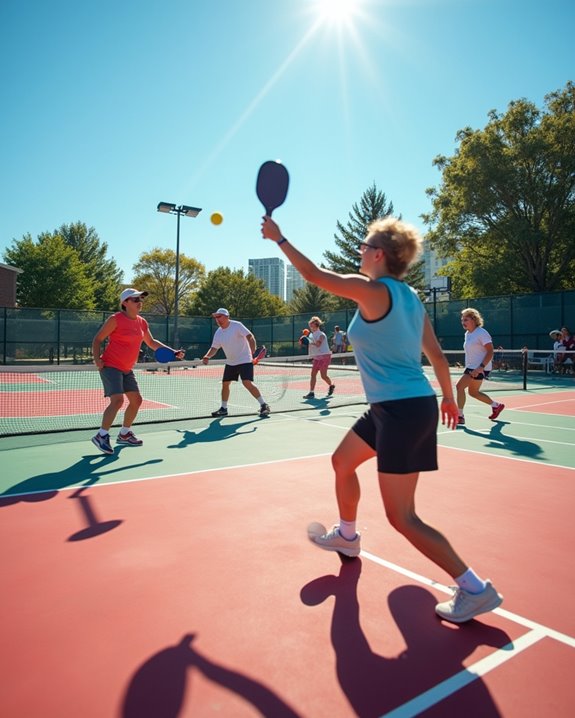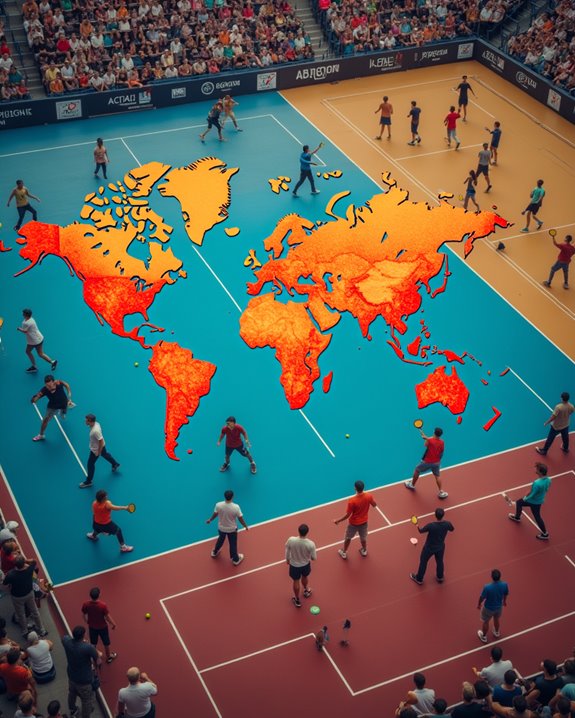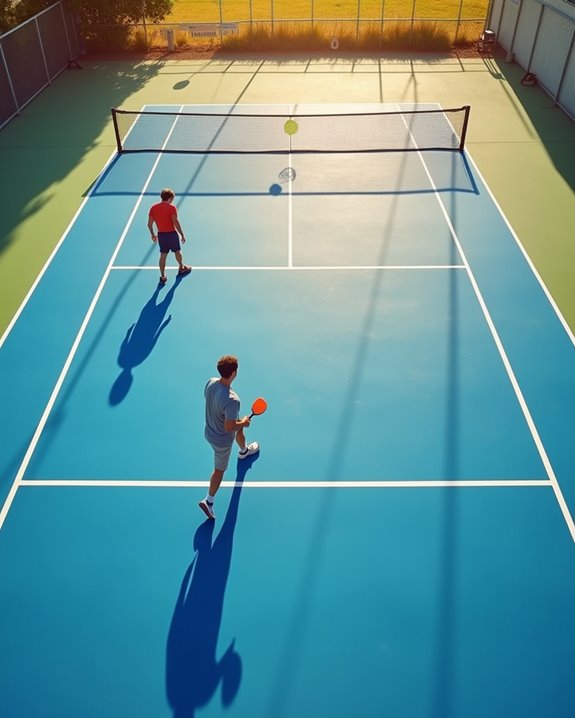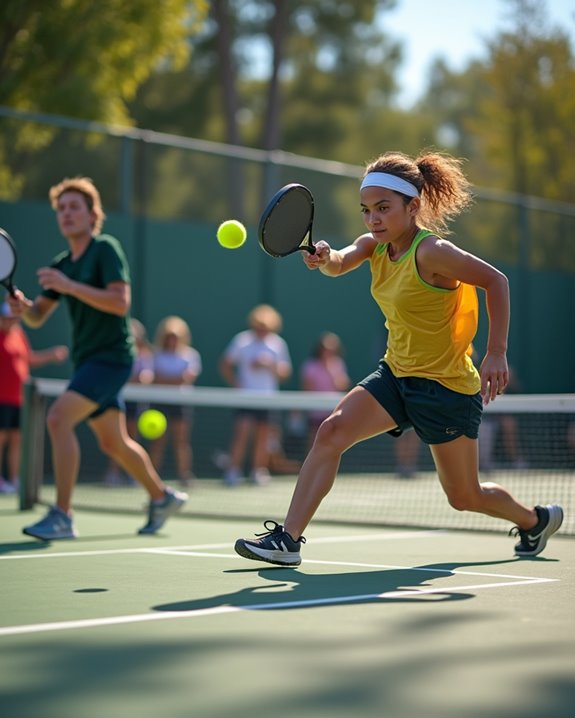Pickleball is America’s fastest-growing sport that blends tennis, badminton, and ping-pong elements. You’ll play on a compact court using paddles to volley a perforated plastic ball over a net. It’s surprisingly easy to learn but offers strategic depth with its unique rules like the “kitchen” (non-volley zone) and two-bounce rule. Whether you’re 8 or 80, the accessible nature of pickleball makes it immediately enjoyable. Discover why millions are grabbing paddles and joining the pickleball craze.
Key Takeaways
- Pickleball is a paddle sport combining elements of tennis, badminton, and table tennis, played on a badminton-sized court.
- Created in 1965 on Bainbridge Island, Washington, it has become America’s fastest growing sport.
- Players use solid paddles to hit a perforated plastic ball over a net, following specific rules.
- Games feature unique elements like the two-bounce rule and a non-volley zone called “the kitchen.”
- Matches can be played as singles or doubles, with points scored only by the serving team.
5 Second-Level Headings for “What Is Pickleball Sport?”
Many newcomers find themselves asking what exactly makes pickleball such a sensation across America. This fastest growing national sport has been simmering in popularity, now boiling over into mainstream culture. When you step onto pickleball courts, you’ll discover a game that blends precise paddle control (think folding egg whites) with strategic positioning.
The growth of pickleball isn’t just impressive—it’s unprecedented. You’ll find players of all ages gathered around nets, enthusiastic to serve up competition in singles or doubles formats. The beauty of this sport lies in its accessibility; you don’t need to be a seasoned athlete to enjoy it. In fact, many players start with wooden paddles that are budget-friendly and perfect for beginners.
Courts are popping up everywhere, from community centers to dedicated pickleball facilities, making it easier than ever to join this delicious sporting revolution.
The Origin Story and Evolution of Pickleball
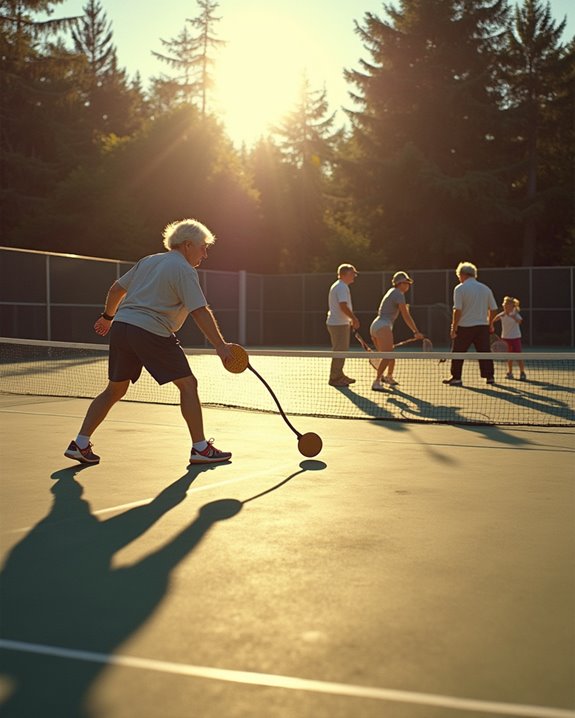
The humble beginnings of pickleball reveal a classic American recipe for success—take a dash of innovation, fold in some family fun, and watch it rise into a national phenomenon.
In the summer of 1965, three dads—Joel Pritchard, Bill Bell, and Barney McCallum—whipped up this sport on Bainbridge Island, Washington, as a way to satisfy hungry-for-fun children. The first official court was established in 1967, simmering slowly until the 1970s when interest began to bubble. By 1984, the United States Amateur Pickleball Association formed and published the first rulebook, setting the stage for structured play.
You’re now witnessing pickleball’s transformation from backyard pastime to America’s fastest-growing sport, culminating in prestigious events like the Pickleball National Championships that attract millions to its distinctive blend of tennis, badminton, and ping-pong.
Equipment and Court Essentials for New Players
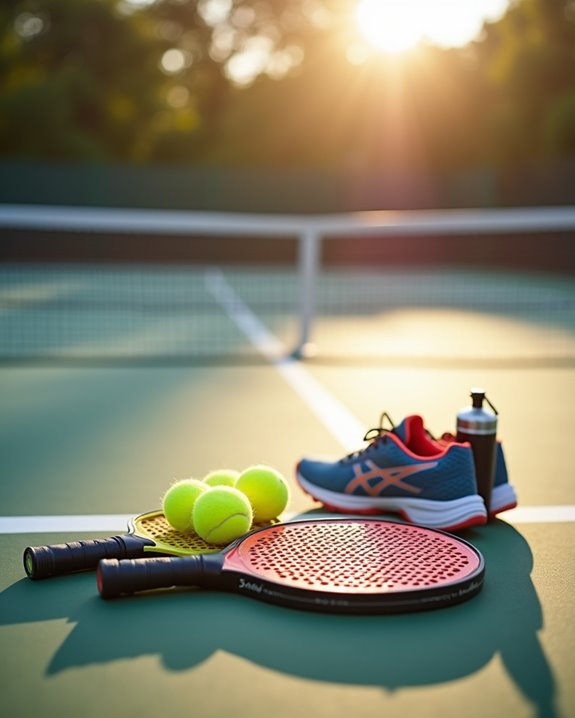
Stepping onto the pickleball court for the first time doesn’t require a pantry full of expensive gear, which makes this sport so deliciously accessible. You’ll need just three main ingredients: a paddle (available in wood, composite, or graphite), a perforated plastic ball, and access to a court.
The pickleball court is perfectly portioned at 20×44 feet—identical to a doubles badminton court—with a net height of 36 inches at the sides and 34 inches in the middle. The court’s signature feature is the “kitchen,” a 7-foot non-volley zone that adds strategic elements to gameplay like salt in a perfect recipe.
To complete your pickleball preparation, simply fold in comfortable athletic apparel appropriate for movement and weather. This simple setup welcomes players of all ages to savor the game! Additionally, choosing the right paddle, such as lightweight paddles with polypropylene honeycomb, can significantly enhance your gameplay experience.
Basic Rules and Scoring System Explained
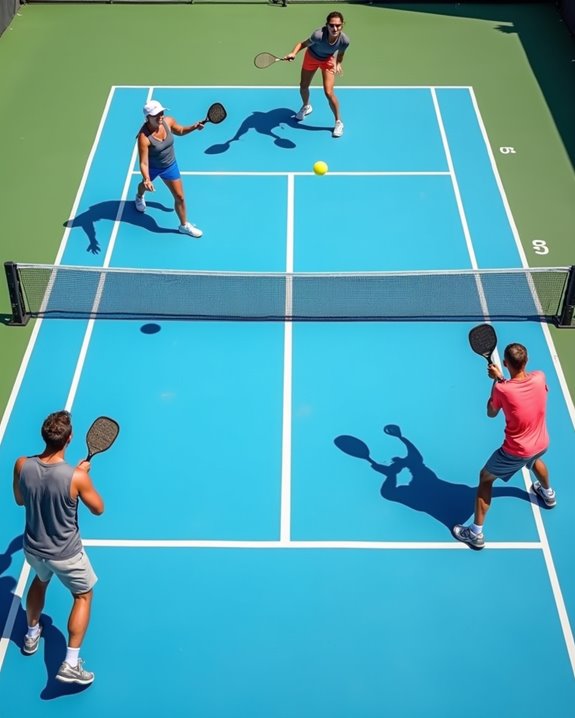
While mastering pickleball might seem like following a complex recipe at first, you’ll quickly discover its rules are as easy to digest as your favorite comfort food.
On the pickleball court, you’ll serve diagonally from behind the baseline into your opponent’s service area. Remember the two-bounce rule—the ball must bounce once on each side before volleys are permitted. Stay out of the non-volley zone (affectionately called “the kitchen”), where you can’t hit airborne shots.
The scoring system is straightforward: only the serving team can score points, with games simmering to 11 points (win by 2). When your opponent wins a rally, they gain the serve but no points. In tournament play, games are often served up as best of three or five sets—perfect for a full pickleball feast!
Techniques and Strategies for Successful Play
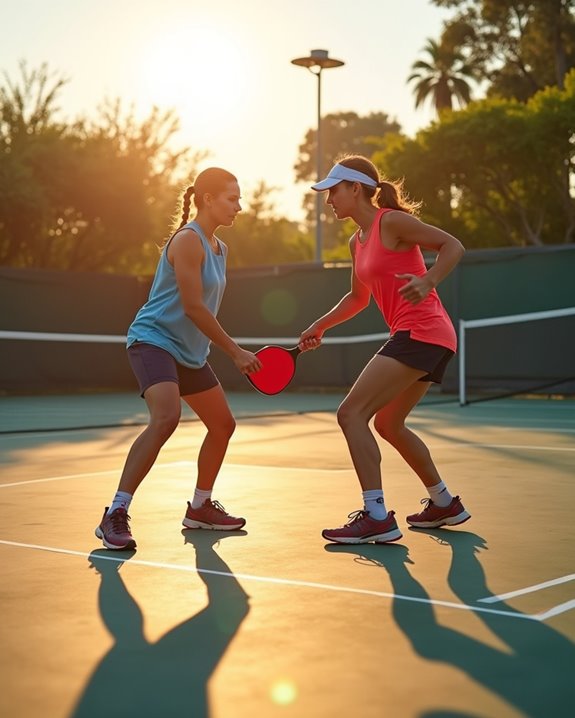
Now that you’ve got the rules simmering in your mind, let’s heat things up with winning techniques that’ll transform your pickleball game from bland to grand!
Begin by whisking together a proper paddle grip and stance—these ingredients form the foundation for crisp shot execution. When serving, think of it as plating your signature dish: strategic placement and a dash of spin will leave opponents scrambling.
A proper paddle grip isn’t optional—it’s the secret sauce that flavors every triumphant pickleball volley.
Master the art of dinking in the non-volley zone (the “kitchen”), where delicate touch creates a banquet of opportunities. For doubles play, fold in seamless communication and teamwork—call shots like a head chef directing the line.
Don’t forget to taste-test your opponents’ weaknesses! Adjust your gameplay strategies by targeting less confident players, and you’ll be serving up victories on pickleball courts everywhere. Additionally, consider using extra-long paddles for greater reach and improved shot precision, which can significantly enhance your overall performance.
Frequently Asked Questions
What Is Pickleball and Why Is It so Popular?
Like badminton’s energetic cousin, pickleball’s a paddle sport you’ll love for its simple rules, accessible equipment, and inclusive community. Its court size, scoring system, and strategic play attract diverse demographics to tournaments nationwide, offering physical benefits.
What Is the Main Difference Between Pickleball and Tennis?
The main difference is court dimensions – pickleball rules require you to play on a much smaller court (20×40 feet) than tennis (36×78 feet), which affects player strategies and equipment choices like paddles versus rackets.
What Is Pickleball and Why Is It Called That?
Coincidentally, you’re asking about pickleball history! It’s a paddle sport played on specialized courts with plastic balls. The name comes from “pickle boats” in crew, not the family dog as many in the pickleball community believe.
Are Pickleballs Just Wiffle Balls?
No, pickleballs aren’t just wiffle balls. They’re specially designed with unique hole patterns, denser materials, and specific sizes for maximum performance. Pickleball manufacturing guarantees they’re more durable for competitive play, unlike recreational wiffle balls.


